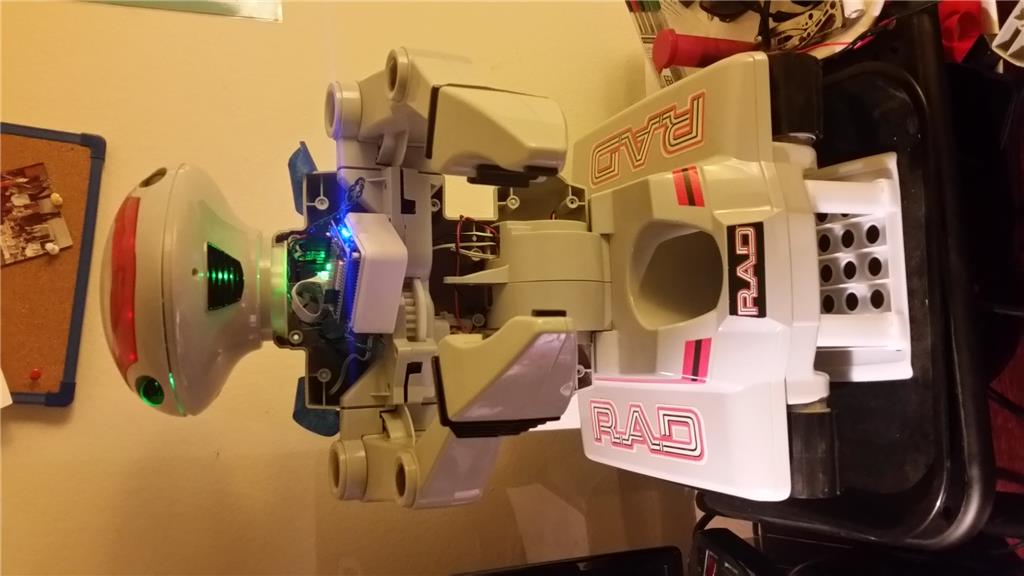saba.rahmani
USA
Asked
— Edited
Hi.
I'm a bit lost and need some help.
I'm trying to convert an old RAD 1.0 robot to run as a remote viewing robot.
I have the existing servos connected through H bridges to D4 and D5.
I have three questions:
1 - I think I'm getting brown outs from too much power demand. Should I use an NPN transistor to deal with this?
2 - I have not been able to figure out how to get the motors to work with the arrow keys.
3 - Is it possible to install a microphone? I assumed the camera would have audio but there does not appear to be any.
Any help would be much appreciated. -Saba in LA


Neither the EZ-B or the camera have a microphone. ARC expects to use a microphone recognized by your computer. The recommendation is to use a bluetooth microphone or headset if you aren't near the computer. Keep in mind that the robot may be quite noisy when moving, so having a microphone actually on the robot may not be very effective.
Alan
One point about your comment I want to clarify. Your robot has servos you installed correct? Becaus the original rad robot didn't have servos, only motors, which might be a problem if you connected them to the ez-b directly.
Wow both these comments help so much.
I know so little I thought servos and motors were synonymous and I could connect motors directly.
Where to start. I will post my system details here next.
That is why I wanted to check. Servos are generally rectangular with 3-4 wires coming from them. The rads motors are dc brushed motors, so they will have 2 wires.
To control the rads motors, which are in the drivetrain, waist, arms and gun I believe, you have to purchase some motor controllers, such as the l298 (2 motor driver) off the store. You then follow the procedure to hooking your motors up to them, and them to the ez-b. This should solve the burnout issue quick.
If your only concerned with the drive train, there are only 2 motors, so 1 motor controller should work. I have a rad that I modified heavily,(and quite frankly, terribly) so I can give you some pointers.
Check out this tutorial.
https://synthiam.com/Tutorials/UserTutorials/72/1
It shows how to connect the EZB HBridge to a RAD Base.
Ok.
First of all I really appreciate everyone's time and help.
My original goal was to use the EZB developer kit to convert an original RAD 1.0 to a tele-presence robot to interact with children. I was surprised to learn that there was video but no sound supplied with the kit. This effectively negated the utility as a TP robot but I thought I would work on the rest and come back to the audio issue later.
My first modification was to remove the 6V battery and replace it with a 7.4V 2 cell LiPo (Venom 2000 20C). I installed the battery and the battery charger in the base of the unit so all the kids would have to do is plug in the robot, not move a battery to a charger. I believe this conversion is ok but it may not be a great idea to have the battery permanently connected to the charger. For the moment I'm using a 7.5V 0.9A power supply.
Once I received the EZB kit I was hoping to replace the old motors with the new servos but found that due to the size and the gears I could not swap them so I decided to keep the original motors. (For this conversion I have eliminated the arm motors and the hip motors, leaving only the two motors that turn the treads for movement).
When I saw the EZB servos had three wires, not two, I did open that EZB continuous servos and I saw that there were boards between the power leads and the motor itself and when I probed them they appeared act as H-bridges (I could be mistaken here). So I harvested these boards and moved them to the original motors. They appear to work if now at a higher voltage of 7V instead of the orginal 5V. I thought this might be ok.
I have mounted the camera in one eye and a cree LED in the other eye with the 4 existing LEDs in the robot face all connected to the EZB brain because I eventually I wanted to program a larsson scanner effect like the toasters on BSG...
Currently the Digitals are connected: D0 Red LED Head D1 Red LED Head D2 Red LED Head D3 Red LED Head D4 L Tread Motor D5 R Tread Motor D6 D7 D8 Cree LED Head D9 Cree LED Head D10 ....
Image file 1
If I understand you correctly, You removed the small circuit board from the servos and plan to use them to drive the Rad motors? If so, the boards wont last long. They are not designed to handle the amount of current those motors will draw. An ezb H-Bridge board or a third party board is your best bet.